“All of life is interesting.” Ernest Hemingway, letter to a friend, 1923
“‘But everything I know hurts me. I don’t know why it should, either.’
‘You mean that you feel it.’
‘I feel it and it does something to me.’” Ernest Hemingway, Islands in the Stream (published 1970)
The following is based on a talk given in the Detroit area July 1.
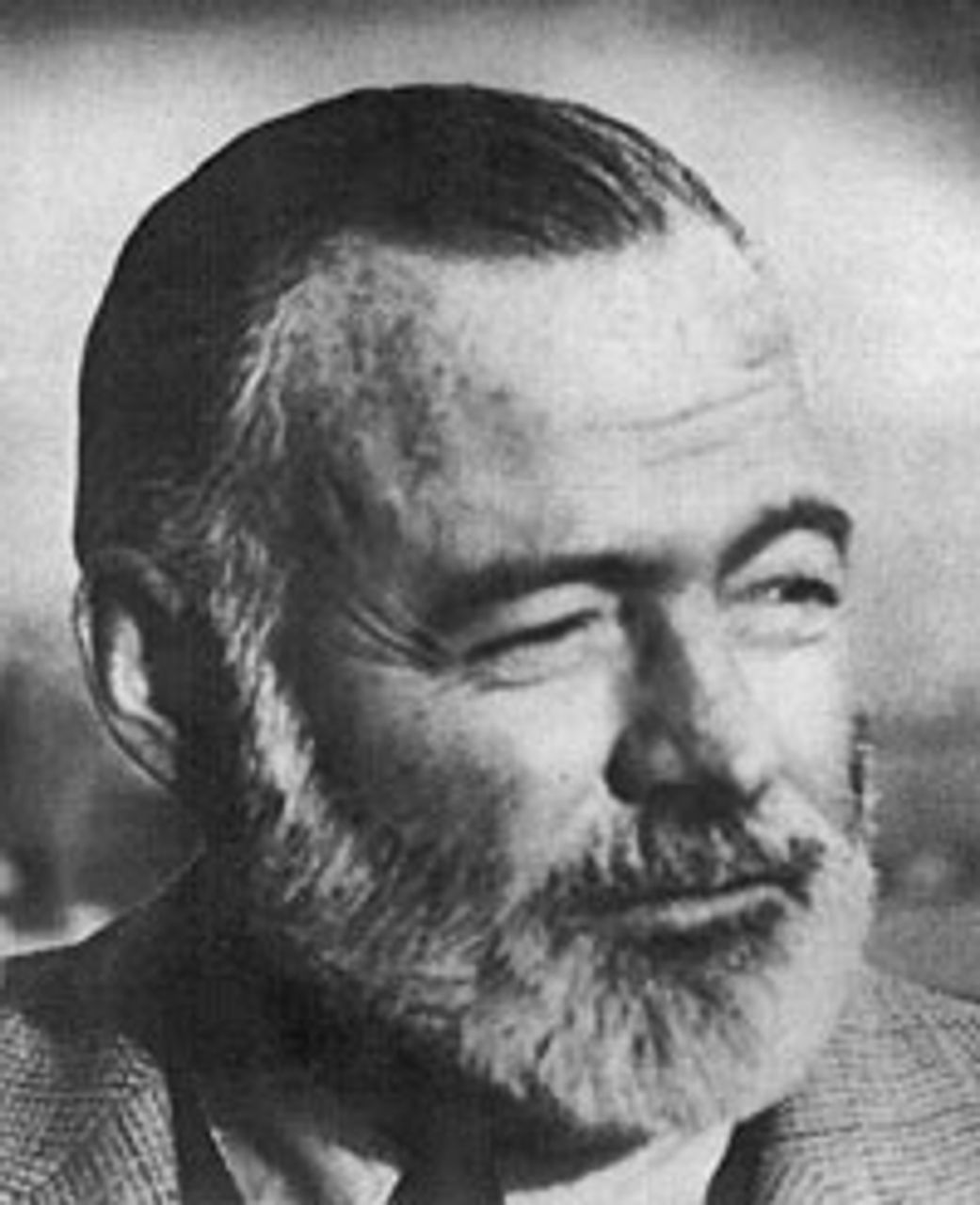 Ernest Hemingway
Ernest HemingwayJuly 2 marked the fiftieth anniversary of the death of American writer Ernest Hemingway, a few weeks before his 62nd birthday. The remarkable novelist and short story writer, one of the most important figures in 20th century American literature, took his own life at his home in Ketchum, Idaho. Mounting health problems and serious depression had taken their toll. He had been by all accounts a tormented man for years.
His death, first presented to the public as accidental, was shocking to many in the US and around the world. Critic Edmund Wilson wrote a few days later in a letter, “it is as if a whole corner of my generation had suddenly and horribly collapsed.” Even to those not intimately familiar with his writing, or who disapproved of or disliked it, Hemingway was a fixture in American cultural life.
He was born and grew up in Oak Park, Illinois (for a time the home and workplace of famed architect Frank Lloyd Wright), a respectable suburb of Chicago. His father was a doctor, and his mother, a cultured woman, had aspired to be a vocalist. They were sober-minded Christians. Both Hemingway’s grandfathers were veterans of the Civil War. Many of Hemingway’s earlier stories are set in northern Michigan, where the family had a cottage on an inland lake and where he spent most summers until he was 20.
Hemingway remains best known for his three most important novels, The Sun Also Rises (1926), A Farewell to Arms (1929) and For Whom the Bell Tolls (1940), as well as numerous short stories and nonfiction works on a host of subjects, including bullfighting in Spain and big-game hunting in Africa. In his fiction and nonfiction he wrote about the two world wars and the Spanish Civil War.
Although certain stories by Hemingway, along with the novella, The Old Man and the Sea (1951), may remain required reading for high school and college students across the US, he has largely dropped out of favor. A certain school of criticism in recent decades has deemed him homophobic and misogynistic, if not racist and anti-Semitic. His hunting and shooting of innumerable wild animals, as well as his affinity for watching bulls and horses get killed in the ring, has also dimmed his reputation for some. No one jumps out of his historical and social skin, and there are problematic portions of Hemingway’s outlook and personality, but his sensibility at its best is compassionate and his view of the world one to be reckoned with.
To remain aloof from his writing would be a terrible mistake, in my view. He wrote many beautiful works, some of them staggeringly beautiful. Hemingway wrote that “A writer’s job is to tell the truth,” and meant what he said. Of course, he didn’t always tell the truth, either because he didn’t understand complex events or behavior or because he fooled himself about them, but one feels the physicality of his mental effort directed toward that end in every work.
Today we have very few writers around who work powerfully and elegantly to represent life as it is. Much charlatanry and laziness abounds. The notion of writing straightforwardly and artistically about people and their lives is scoffed at in literary and academic circles. But then such circles are not good for much of anything.
Hemingway was a major figure to a number of generations. It was nearly impossible to write in the same way, and not only in English, after the publication in the mid-1920s of his first concise, firm, brilliant stories. Ford Madox Ford, a fine stylist himself, wrote that “Hemingway’s words strike you, each one, as if they were pebbles fetched fresh from a brook. They live and shine, each in its place.”
He influenced a great number of writers to one degree or another in the middle of the 20th century and beyond, including James M. Cain, James T. Farrell, John O’Hara, William Saroyan, Horace McCoy, Dashiell Hammett, Raymond Chandler, Nelson Algren, Irwin Shaw, Norman Mailer, James Jones, Ralph Ellison, J.D. Salinger, Richard Yates, Raymond Carver, Richard Ford and others, in English.
He also had a significant impact, for better or worse, on existentialist writers in France, including Albert Camus in particular and Jean-Paul Sartre, as well as on the later practitioners of the French “new novel.” German writer Heinrich Böll is considered to have been influenced by Hemingway.
His writing was immensely popular in the Soviet Union, where more than a million copies of his books appeared. Yevgeny Yevtushenko paid him poetic tribute and the critic Ivan Kashkin, considered the leading Soviet expert on his writing and with whom Hemingway corresponded, explained his attraction for younger writers: “The fact that he can look at life without blinking; that his manner is all his own; that he is ruthlessly exacting on himself, making no allowances, and straightforward in self-appraisal; that his hero keeps himself in check, and is ever ready to fight nature, danger, fear, even death, and is prepared to join other people at the most perilous moments in their struggle for a common cause.”
Very few writers had written passages quite as direct and clean, but suggestive, as this, for example, in one of Hemingway’s Nick Adams stories about northern Michigan (written in Paris and Pamplona, Spain in 1924):
“For some time as he walked Nick had been in sight of one of the big islands of pine standing out above the rolling high ground he was crossing. He dipped down and then as he came slowly up to the crest of the bridge he turned and made toward the pine trees.
“There was no underbrush in the island of pine trees. The trunks of the trees went straight up or slanted toward each other. The trunks were straight and brown without branches. The branches were high above. Some interlocked to make a solid shadow on the brown forest floor. Around the grove of trees was a bare space. It was brown and soft underfoot as Nick walked on it. This was the over-lapping of the pine needle floor, extending out beyond the width of the high branches. The trees had grown tall and the branches moved high, leaving in the sun this bare space they had once covered with shadow. Sharp at the edge of this extension of the forest floor commenced the sweet fern.” (“Big Two-Hearted River: Part I”)
Or this type of dialogue:
“‘She told a lot of people you were engaged.’
‘We weren’t engaged,’ Nick said.
‘It was all around that you were.’
‘I can’t help it,’ Nick said. ‘We weren’t.’
‘Weren’t you going to get married?’ Bill asked.
‘Yes. But we weren’t engaged,’ Nick said.
‘What’s the difference?’ Bill asked judicially.
‘I don’t know. There’s a difference.’
‘I don’t see it,’ said Bill.
‘All right,’ said Nick. ‘Let’s get drunk.’
‘All right,’ Bill said. ‘Let’s get really drunk.’
‘Let’s get drunk and then go swimming,’ Nick said.
He drank off his glass.” (“The Three-Day Blow”)
The directness and accessibility had little to do with naturalism. Hemingway laid great stress on the fact that he ‘made everything up,’ that the fictional, if worked at deliberately and thoughtfully, could present more of the truth about life than life itself. He seems to have felt that a dispassionate, precise dissection of events and people opened the way to the deepest feelings and thoughts, that if readers could be made to see clearly, they would draw certain conclusions about the world. In some of his stories and novels, this process is set in motion. At its weakest, his writing suffers from an overly self-conscious coldness or stoicism or minimalism.
Hemingway argued that if a writer knew something well, he could leave out important details and that would strengthen the overall effect. (In the first story cited, it is the fact that Nick Adams has just returned from the war and has set out on a trip to recover, a fact never referred to directly by the author.) This is not the same thing as being enigmatic or elliptical for its own sake, although Hemingway sometimes makes mistakes along these lines too. “If you leave or skip something because you do not know it, the story will be worthless,” he observed. We have a great deal of that at present.
Hemingway was a serious figure with serious ideas, however some of them they may be judged today. He was prepared by events and by previous generations. He was influenced by the great Russian and French novelists of the 19th century, as well as Mark Twain and others in America. (He claimed that “all modern American literature” came from Twain’s Huckleberry Finn.) Hemingway studied the world and the activities he undertook in depth. However readers may feel in the end about bullfighting or deep-sea fishing as subjects for works of art, they are not liable to feel that Hemingway has shortchanged them. To read him is to learn about his interests intimately and elegantly. He shares knowledge in an immensely artistic fashion. Even when his inspiration and purposefulness faltered after World War II, he continued to write precise, intelligent prose.
Writing or speaking comprehensively about Hemingway is difficult because he was a very large figure, who aspired either to do and be everything, or at least to write about it. He hunted and fished, he went to war, he followed boxing and bullfighting, he bet on races, he traveled extensively, he drank and ate a lot, he showed off and postured shamelessly, he loved a number of people and married four times, he read voraciously, he gossiped endlessly (“Shoot me the dope”) and quarreled quite a bit (“It will be a great pleasure to see you again in Paris and somewhat of a pleasure to knock you down a few times”).
Hemingway’s letters are amusing, often obscene, scurrilous and irresponsible. A writer capable of great calm and objectivity, he possessed a deep streak of subjectivism and vindictiveness—he was extremely touchy about criticism and held grudges for years—and suffered from insecurity and even melancholia. He could be, at times, a terrible bully. There was a strand of nihilism and morbidity in his thinking, which emerged most strongly when he was personally or socially disconsolate. His father committed suicide in 1928, and Hemingway spent a good deal of time contemplating death. Courage in the face of inevitable death is a recurring theme.
In a very fine essay, “Hemingway: Gauge of Morale,” published in 1941, Edmund Wilson suggested that for the writer “the brutality of life” was always “bound up with the enjoyment.”
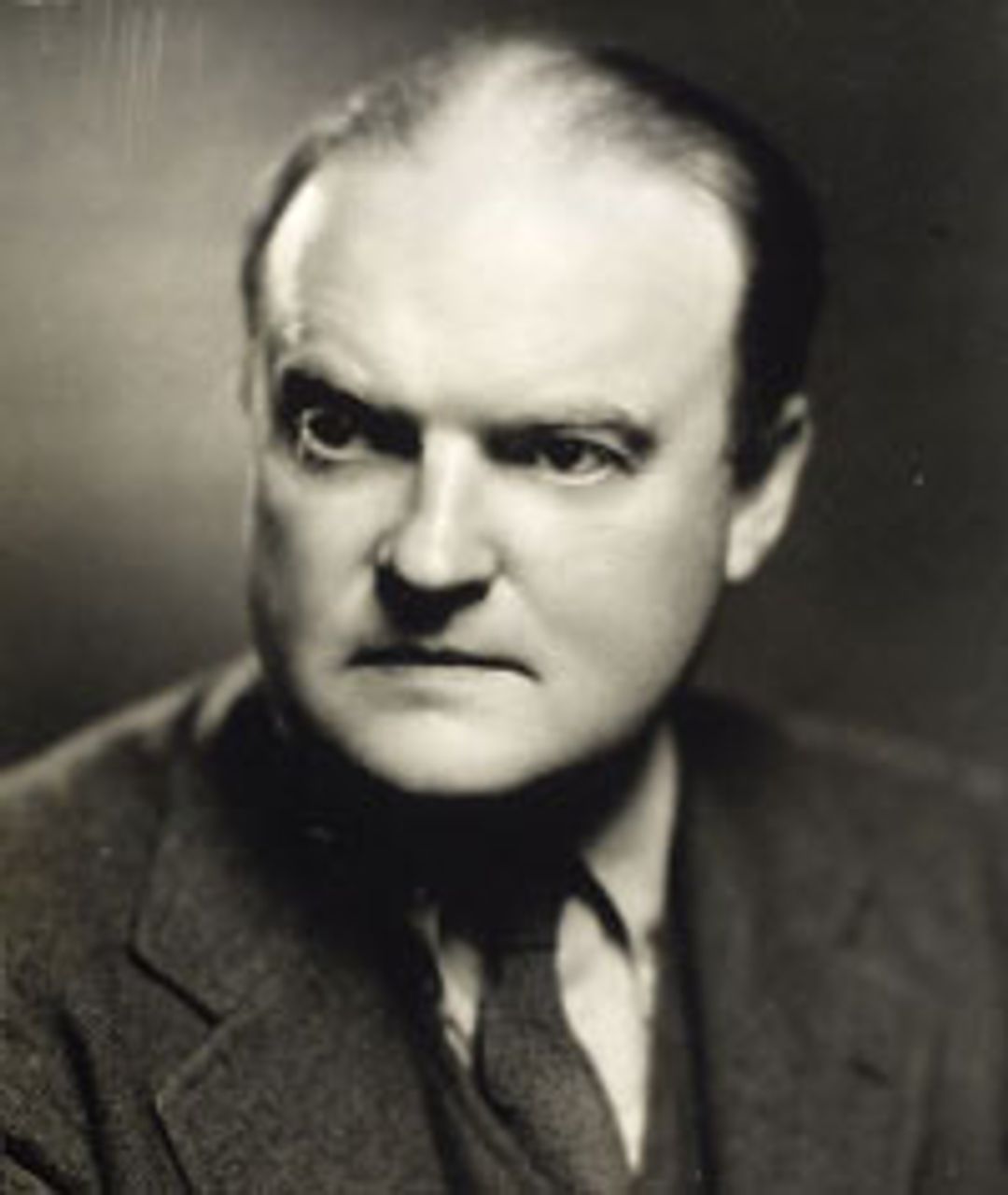 Edmund Wilson
Edmund WilsonAside from the psyche Hemingway developed within his family and other relationships, there is also something about the America of his day in this, a power that came into its own as the global capitalist system entered general and historic decline, marked by the extreme violence and destructiveness of World War I. In a historical context where European capitalism survived the revolutionary upheavals in the wake of that conflict, American industry and culture proved to have considerable reserves. This tension, between this overall convulsive decline and these “considerable reserves” in the US, perhaps finds a reflection in the contradictions of Hemingway and his work.
Experiencing—and even occasionally enjoying and being attracted to—the brutality of life, and being deeply hurt by it at the same time, this seems to animate a good deal of Hemingway’s work. He turned to bullfighting, he hunted lions, he battled 1,000 pound fish. Something had been set off in him early on that he could never get away from, that he didn’t want to get away from.
Born the year after the US emerged as a global imperial power, in the Spanish-American War, Hemingway lived through and reflected on an era of great turmoil. “How we are,” he would write in a letter in 1950, “is how the world has been,” rejecting what he termed the psychoanalytic interpretation. And the world had gone through a great deal in the previous half-century.
Two world wars, revolution and counterrevolution in Russia and Europe, an era of global class war, the rise of fascism, the consolidation of the US as the dominant power, the Cold War reaction and stagnation… that was ‘how the world had been’ by the latter period of his life. In 1947, following the victory of the US and its allies in “the good war,” the supposed war for democracy against fascism, Hemingway wrote William Faulkner, “Things [have] never been worse than now.”
His politics were of a certain American left variety, an amorphous mix of socialism, liberalism and individualism. He paid attention to political events, although he sometimes claimed not to, and he was encouraged or discouraged as the century moved along. During the Spanish Civil War he submitted to the politics and discipline of the Spanish Communist Party and Soviet Stalinists, not the only American “free spirit” to do so, although he writes mistrustfully about them.
In the early 1930s, Hemingway asserted that he had desired a social revolution immediately after the First World War (he refers more than once to the murder of Rosa Luxemburg and Karl Liebknecht), but had been disillusioned by events, and there is no reason to disbelieve him, although there is scant evidence in his writings or letters of the time. Perhaps he wanted the revolution, but he also wanted many things to remain the same—life in Key West and Paris, bullfighting in Pamplona, hunting in northern Michigan, the “brutal enjoyment” of life.
Although Hemingway was not a writer attracted immediately and instinctively to social questions, his whole work, observed Edmund Wilson, was “a criticism of society.” Hemingway responded to every pressure “of the moral atmosphere of his time, as it was felt at the roots of human relations, with a sensitivity almost unrivalled.” Wilson speaks about Hemingway’s “barometric accuracy.” He felt things truly and he could not help recording what he felt. He described to the best of his ability and understanding the first half of the 20th century, which made him and knocked him about, and its inhabitants.
Why did he write as he did? That’s a complicated question, which precludes an exhaustive answer, but some elements of it can be suggested.
Hemingway was a product of America in its transition to being an imperial power. Bitter labor struggles erupted in the last decades of the 19th century, some of them in the Chicago area, where he was born. The democratic impulses set off by the Civil War still held sway over large sections of the educated middle class, like the Hemingways. A far higher level of culture existed in these social layers than in their equivalents today.
Hemingway didn’t go to college; he was largely self-taught. He read voraciously, endlessly, until the end of his life. Some of the sober-mindedness of his family and background, its essential practicality, as well as certain important moral qualities, communicated themselves to him and his writing.
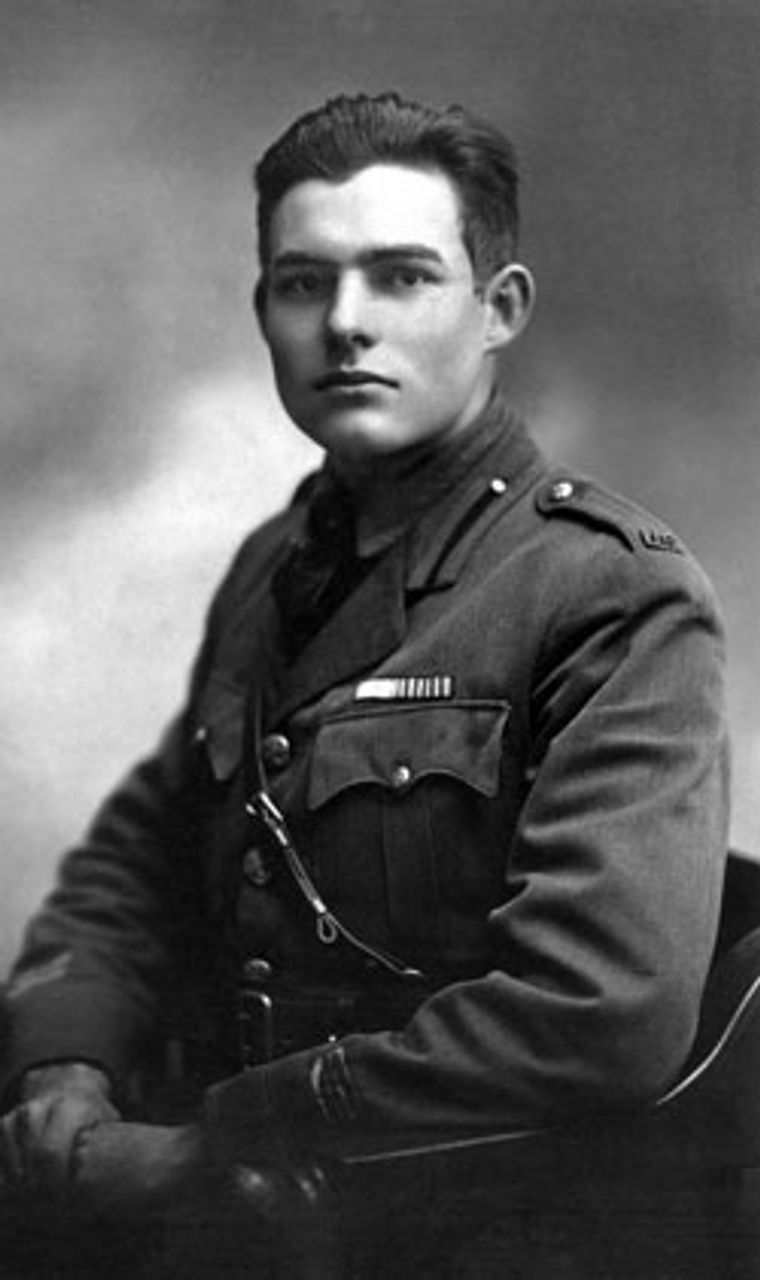 Hemingway in 1918
Hemingway in 1918World War I was a massive event in Hemingway’s life, but then it was a massive event in the life of the world. Every individual is shaped by social and historical processes, but some events come crashing down on people at a formative stage in their emotional and intellectual development and have a particularly powerful, lifelong impact. Such was the First World War for Hemingway, who was about to turn 18 when the US entered the conflict.
He signed up as a Red Cross ambulance driver, and ended up assisting Italian forces confronting the Austrian army on the northeastern Italian front. Shortly after he arrived, he was seriously wounded by Austrian mortar and machine gun fire in fighting on the Piave River, a battle that ultimately cost Austria-Hungary nearly 200,000 casualties.
Hemingway, not long out of high school, lay in a hospital bed, for a time unable to ask the doctors, because of language difficulties, whether he would lose a leg. “The wholesale shattering of human beings” in which he took part, as Edmund Wilson put it—and the horror, anxiety and fascination the events engendered—never left him. “The boy from the American Middle West” was given a touch of panic which he never lost.
His writing style corresponded to certain American traditions (Twain, Thoreau and others), compounded by the experience of World War I and Europe in the early 1920s.
After the war a strong reaction occurred against the elaborate, ornate, piled-up language and culture that some blamed for not preventing the madhouse of world war and the deaths of more than 16 million people.
There was a reaction too against the florid propaganda rhetoric and lies of the competing powers. The war, Henry James suggested, had “used up” words. Words, James said, “have, like millions of other things, been more over-strained and knocked about and voided than in all the long ages before, and we are now confronted with a depreciation of all our terms.”
The Dadaists reacted as they did, with absurdity and bitter derision. Ezra Pound put in practice his dictum that to write poetry was to condense. Bertolt Brecht reacted against expressionist overflow, and turned, like Hemingway, to sports and boxing. Toughness, brevity, compactness, matter of factness and unsentimentality became the rage in certain circles, although not by any means in all.
Hemingway was based in Paris for much of the 1920s, where he met Gertrude Stein (one of his early influences), Ezra Pound, F. Scott Fitzgerald, James Joyce, Ford Madox Ford, John Dos Passos and other writers, along with painters such as Picasso, Miró, Gris and others. It was an interesting time to be there.
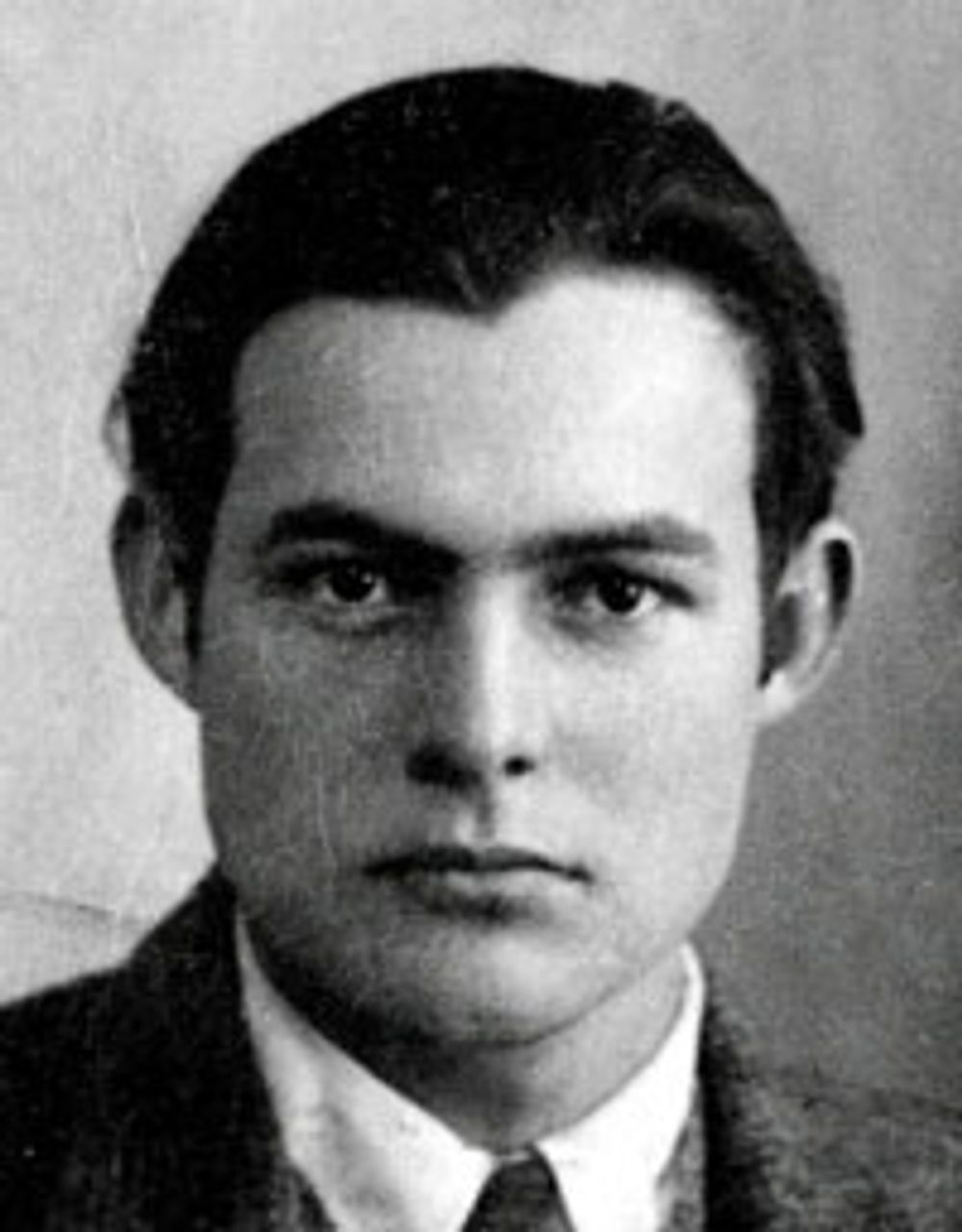 Hemingway in 1923
Hemingway in 1923In Our Time, Hemingway’s first book of stories, appeared in 1925 and made an immediate impact. It contained stories about northern Michigan as well as vignettes from Europe after the war. It contained very fine work, including, “Indian Camp,” “The Doctor and the Doctor’s Wife,” “The End of Something,” “The Three-Day Blow” and “Big Two-Hearted River.” Hemingway’s remarkable expressive power was already evident.
“Indian Camp” begins, “At the lake there was another rowboat drawn up. The two Indians stood waiting,” and goes on to tell the story of a visit by a doctor and his son (Nick Adams again) to an Indian camp in northern Michigan where the doctor has to help deliver a baby. The poor woman screams and screams during the difficult birth—there is no anesthetic. The doctor tells his son, “Her screams are not important. I don’t hear them because they are not important.” He’s not being cold-hearted, it is simply the situation he is confronted with. However, the doctor and his son later discover that the ‘unimportant’ screams drive the Indian woman’s husband to slit his own throat with a razor. “Why did he kill himself, Daddy?” “I don’t know Nick. He couldn’t stand things, I guess.”
Hemingway’s first novel, The Sun Also Rises, brought him international recognition. It is about a group of people who have been damaged or worn out by the First World War, set mostly in Spain during a bullfighting festival. The war or its aftermath has triggered something in them that they don’t know what to do with. They drink, fight, sleep with one another, all pretty unhappily. The people are mostly smashed up and unhappy, but Hemingway’s sensual treatment of life offers something else as a possibility. All is not lost, even for this generation.
Chapter III begins: “It was a warm night and I sat at a table on the terrace of the Napolitain after Robert had gone, watching it get dark and the electric signs come on, and the red and green stop-and-go traffic-signal, and the crowd going by, and the horse-cabs clippety-clopping along at the edge of the solid traffic taxi traffic, and the poules [prostitutes] going by, singly and in pairs, looking for the evening meal.”
In a letter to his father in 1925, who disapproved of the morally questionable subject matter of his work, Hemingway explained firmly: “I’m trying in all my stories to get the feeling of the actual life across—not to just depict life—or criticize it—but to actually make it alive. So that when you have read something by me you actually experience the thing. You can’t do this without putting in the bad and the ugly as well as what is beautiful. Because if it is all beautiful you can’t believe in it. Things aren’t that way.”
A Farewell to Arms, Hemingway’s second novel, dealt with his experiences during World War I, including his wounding and his affair with an American nurse (British in the novel) a number of years older than him. It is a more complex book than his first novel, and elegantly written, dealing with the boredom and horrors of the war and the physical suffering it produced, as well as its emotional impact on all those involved. The portions treating an Italian army retreat, which also exposes the brutality and stupidity of those in charge, are the strongest sections of the book.
The novel captures, as Wilson put it, “the strangeness of life in the army for an American in Europe during the war.” However, the nurse, Catherine Barkley, never truly comes to life for the reader. She is always promising to be the hero, Frederic Henry’s “good girl,” “brave girl,” and is not very well developed. And, as Wilson notes, while the characters’ situation ends up a tragedy, “the lovers are shown as innocent victims with no relation to the forces that torment them,” i.e., the war story and the love story are never bound together in a convincing fashion. Perhaps Hemingway, in this case, was too true to the facts of his own life.
In the early 1930s, now with a residence in Key West, Florida, Hemingway wrote his book about bullfighting, Death in the Afternoon (an extraordinarily evocative title). He claimed that the bull ring was the “only place where you could see life and death, i.e., violent death now that the wars were over… I was trying to learn to write, commencing with the simplest things, and one of the simplest things of all and the most fundamental is violent death.”
Hemingway was certainly serious about courage, honor and facing up to death, relentlessly so, but I’m not sure this is very convincing as a rationale, and the book, again beautifully done (its inclusion of photographs and precise descriptions give it the feeling of some of the surrealist works of the time), tries too hard to win us over or at least intimidate us. He was being criticized by writers now turning to the left, whom he considered political Johnny-come-latelies, for not treating the social crisis produced by the Depression.
In Green Hills of Africa (1935), Hemingway recounted his adventures during a safari in 1933. There is some lovely writing, and his comments on American literature are of interest, but on the whole, this is not a very compelling work. Wilson complained that the book was dull, and that “the only thing we learn about the animals is that Hemingway wants to kill them.” As for the Africans, “the principal impression we get of them is that they were simple and inferior people who enormously admired Hemingway.” A little harsh perhaps, but the comment has some merit.
Wilson suggests the impact of the stock market crash on Hemingway’s works of the early 1930s: “They are full of the apprehension of losing control of oneself which is aroused by the getting out of hand of a social-economic system, as well as the fear of impotence which seems to accompany the loss of social mastery. And there is in such a story as A Clean Well-Lighted Place the feeling of having got to the end of everything, of having given up heroic attitudes and wanting only the illusion of peace.”
When Hemingway treats life in the US in his early stories, he writes best about characters like himself. His American working class characters, along with his boxers, cyclists and gamblers, do not entirely convince. He strains to get at their experience. When it came to Spain later on, he seemed able to do it, to write about bullfighters and waiters and prostitutes with considerable relaxation and authenticity. The distancing seemed to suit his style, or perhaps it was simply maturity.
The Capitol of the World (first published in 1936) is a wonderfully realized story about a pension in Madrid, its inhabitants and employees. One of the latter is a waiter named Paco from “a village in a part of Extramadura [in western Spain on the border with Portugal] where conditions were incredibly primitive, food scarce, and comforts unknown and he had worked hard ever since he could remember.” The residents of the pension include a number of “second-rate matadors,” along with others associated with bullfighting. We learn about all of them, including a pair of priests. Paco aspires to be a matador and during a mock bullfight conducted in the pension’s kitchen with meat knives and napkins, he is fatally injured.
Hemingway concludes his story: “The boy Paco had never known about any of this nor about what all these people would be doing on the next day and on other days to come. He had no idea how they really lived nor how they ended. He did not even realize they ended. He died, as the Spanish phrase has it, full of illusions. He had not had time in his life to lose any of them, nor even, at the end, to complete an act of contrition. He had not even had time to be disappointed in the Garbo picture which disappointed all Madrid for a week.”
Hemingway tended to experience the world in the sharpest sense not so much divided into social classes, as into the active and inactive, the doers and those who sat around and fussed about things—and there is something very early 20th century American about this. In the first category, in addition to himself, he included hunters, fishermen, bullfighters, soldiers, bicycle racers, boxers, sailors, jockeys, peasants, circus performers, prostitutes, gamblers and more; in the second he lumped the emotionally paralyzed, critics, the impotent, cowards, effete writers and politicians, bitchy women, drawing room artists, speculators, and so forth.
When the cynical, tough-guy posturing shows up overwhelmingly in Hemingway, as in anyone, it is irritating. That perhaps reaches a high point in To Have and Have Not (1937), several different, overlapping stories that center on the character of Harry Morgan, a rough, individualistic fishing boat captain in Key West during the Depression. Interestingly, the only novel Hemingway set in the US, To Have and Have Not (which did spawn two intriguing Hollywood films, the Howard Hawks film with the same title and Michael Curtiz’s The Breaking Point) bears the unfortunate imprint also of the “proletarian novel” and the influence of such retrograde figures as the Communist Party’s Mike Gold.
The novel’s central concern, individualism versus solidarity, is not effectively demonstrated and feels worn especially for the occasion.
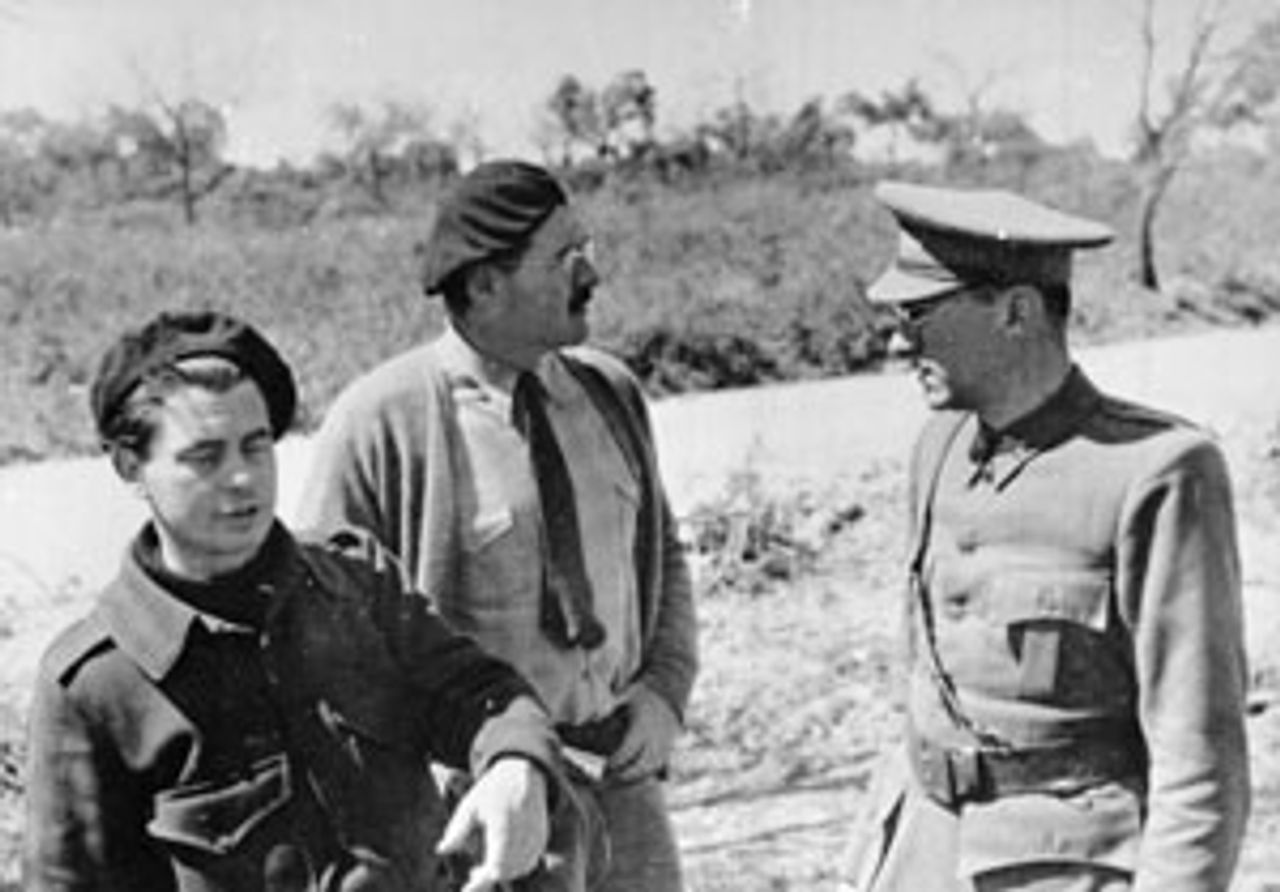 Hemingway (center) in Spain during Spanish Civil
Hemingway (center) in Spain during Spanish CivilWar, 1937.
Hemingway went to cover the Spanish Civil War in 1937 and 1938; he also worked there on the documentary, The Spanish Earth, with the left-wing Dutch filmmaker Joris Ivens. They later screened the film for Eleanor and Franklin Roosevelt at the White House. Hemingway largely accepted the politics and discipline of the Communist Party, although he saw through some of the Stalinist propaganda. In his stories about Spain and his novel, For Whom the Bell Tolls, some of the cynicism of the Stalinist operations comes through.
The novel is his most ambitious effort. He relates the events over several days in the life of Robert Jordan, a young American volunteer serving in the International Brigades and attached to a guerrilla band, as he prepares to blow up a bridge. The explosion is vital to an offensive planned by the Loyalist army, with its Soviet and French advisers, against the Francoist fascist forces. The offensive is doomed, in fact, and Jordan tries unsuccessfully to have it called off. Meanwhile, he goes ahead with his plans, in conjunction with the members of the embattled and divided group of guerrillas. He also commences a torrid love affair with a young fighter named Maria, in “a love story that is headed straight for Hollywood,” complained Wilson.
It would be wrong, however, to underestimate the power of the book, which endures. Wilson wrote that in For Whom the Bell Tolls Hemingway had “largely sloughed off his Stalinism” and that “Hemingway the artist is with us again, and it is like having an old friend back” (the latter comment comes from “Return of Ernest Hemingway,” 1940). Wilson observed that “The whole picture of the Russians and their followers in Spain…looks absolutely authentic,” and indeed Hemingway was officially denounced by the Stalinist press in the US.
The book begins and ends with Jordan lying on the floor of a pine forest, an image that brings back some of Hemingway’s earliest concerns and emotions, associated with summers spent near Walloon Lake and Horton Bay in Michigan, but now the images are charged with world-historical and tragic dimension. The “boy from the American Middle West” was now in the midst of vast events, with equally vast consequences. As Jordan prepares for death in an apparently hopeless cause, he can feel “his heart beating against the pine needle floor of the forest.”
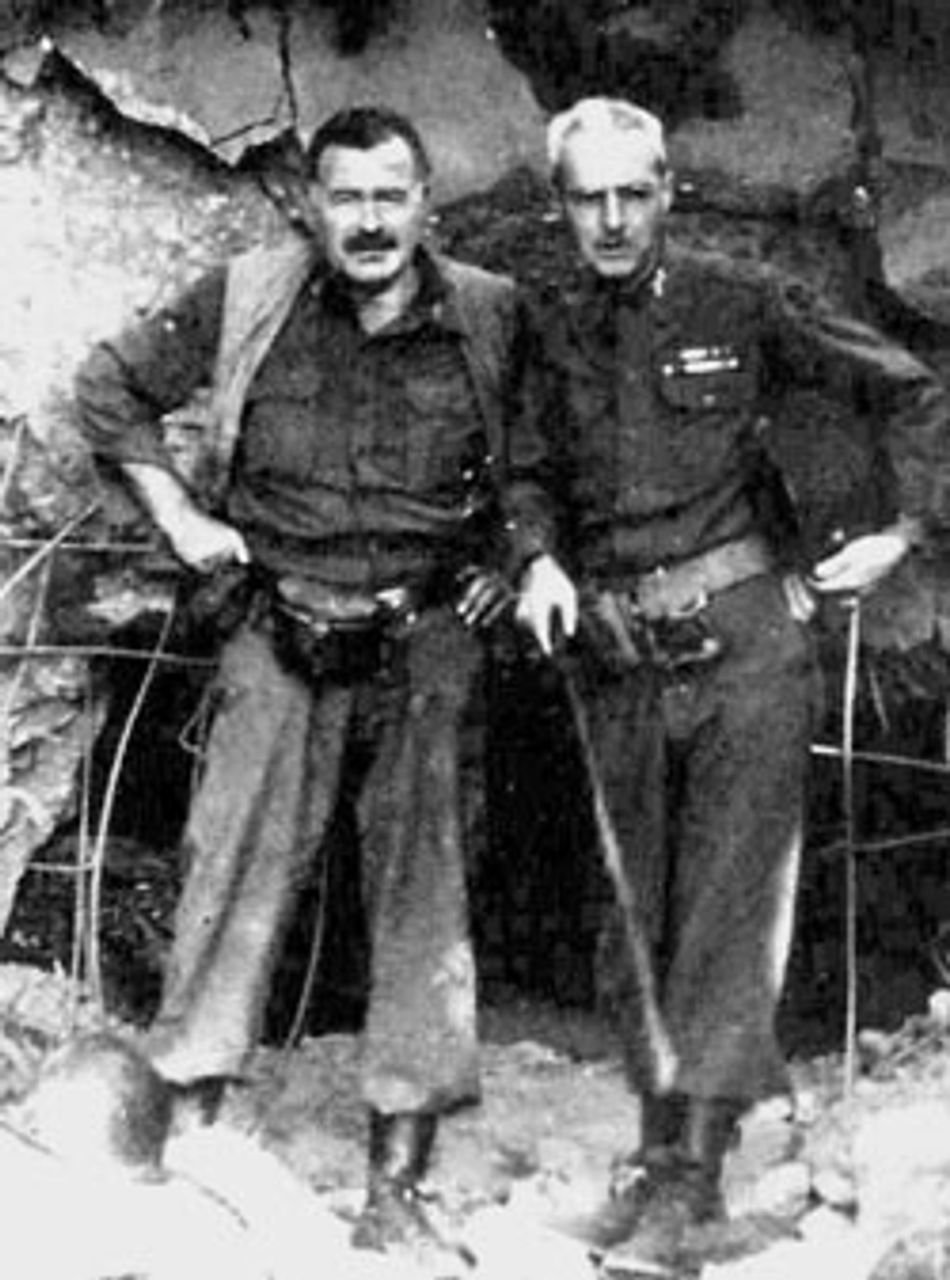 Hemingway in 1944
Hemingway in 1944Hemingway ventured forth to cover and participate in World War II in 1944, now embarked on his third marriage, to the left-wing journalist Martha Gellhorn, and living most of the year in Cuba. He witnessed the D-Day landings and liberation of Paris. He was officially gung-ho about World War II, but his fictional writings on the subject, in his postwar novel, Across the River and Into the Trees (1950), the portion of Islands in the Stream (edited and published posthumously in 1970) concerned with the war, and his story “Black Ass at the Crossroads,” are among the flattest, harshest, most unpleasantly cynical pieces he wrote. Contrary to his probable intentions, something about the real nature of American imperialist intervention in the war got through to him. And there is that enigmatic comment to Faulkner in 1947, “Things [have] never been worse than now.”
His remaining writing is generally weak. The disappointments of the 20th century undoubtedly weighed on him, as they did on every sensitive artist and intellectual. The experience in Spain, the machinations of the Stalinists, although he didn’t understand them as George Orwell did, were disillusioning. The outcome of the Second World War, the mood of reaction and conformism in the US, the deaths (Fitzgerald, Joyce, Stein) or betrayals (Dos Passos) of many of his contemporaries, all that must have helped to depress Hemingway. There is far less purpose to what he wrote, less important commitment.
The Old Man and the Sea (1952), which helped Hemingway win the Nobel Prize for literature, about an aging fisherman and his heroic but ultimately defeated effort to bring in a great fish, is well carried out, but its slightly condescending and sentimental tone is grating. And it almost celebrates resignation and defeatism. Also, there is the matter of what Hemingway was not writing about in the early 1950s. The novella sidesteps the new and difficult world and American situation. The Soviet critic Kashkin wrote with some justice and understatement that The Old Man and the Sea seemed to ignore “important post-war problems.”
The part of Islands in the Stream that deals with his children and domestic routine are convincing and even charming, but the rest is self-aggrandizing or, again, cynical. The Garden of Eden (also edited and published posthumously, in 1986) reads elegantly, but its narrow concerns, the sexual and psychological goings-on among a threesome on the French Riviera and Spain in the 1920s, bear the objective influence of precisely the “psychoanalytic interpretation” of life that Hemingway was inveighing against. True at First Light (published in 1999), about the African trip in the early 1950s, is largely forgettable.
Hemingway despised much of what was occurring in the US. In 1950, he addressed a letter to Sen. Joseph McCarthy (which may not have been mailed): “You can come down here and fight for free, without any publicity, with an old character like me who is fifty years old and weighs 209 and thinks you are a shit, Senator, and would knock you on your ass the best day you ever lived.”
A year later he wrote to Wilson: “Now that we live in a time of such violence, false-witness, inaccuracy, calumnies and lies for profit I am going to spend the rest of my life trying to be just. That doesn’t mean that there are not people that should be justly hanged though.”
The best thing he wrote after 1940 was his memoir of the 1920s, A Moveable Feast (published posthumously in 1964). There he came alive once again. How accurate the memoir is may be called into question, Hemingway himself termed it a fiction, but it is exquisitely composed.
In 1958, he told George Plimpton in an interview for the Paris Review that “A writer without a sense of justice and of injustice would be better off editing the yearbook of a school for exceptional children than writing novels… The most essential gift for a good writer is a built-in, shockproof, shit detector. This is the writer’s radar and all great writers have had it.”
He told Plimpton, “From things that have happened and from things as they exist and from all things that you know and all those you cannot know, you make something through your invention that is not a representation but a whole new thing truer than anything true and alive, and you make it alive, and if you make it well enough, you give it immortality. That is why you write and for no other reason that you know of. But what about all the reasons that no one knows?”
His last few years were not happy ones. Two plane crashes in 1952 in Africa had nearly killed him; in fact, obituaries were published. He suffered from diabetes and other illnesses. In 1956, he was told to stop drinking, to no effect. He was reportedly consuming great quantities of liquor. He was treated at the time for high blood pressure, liver disease, and arteriosclerosis.
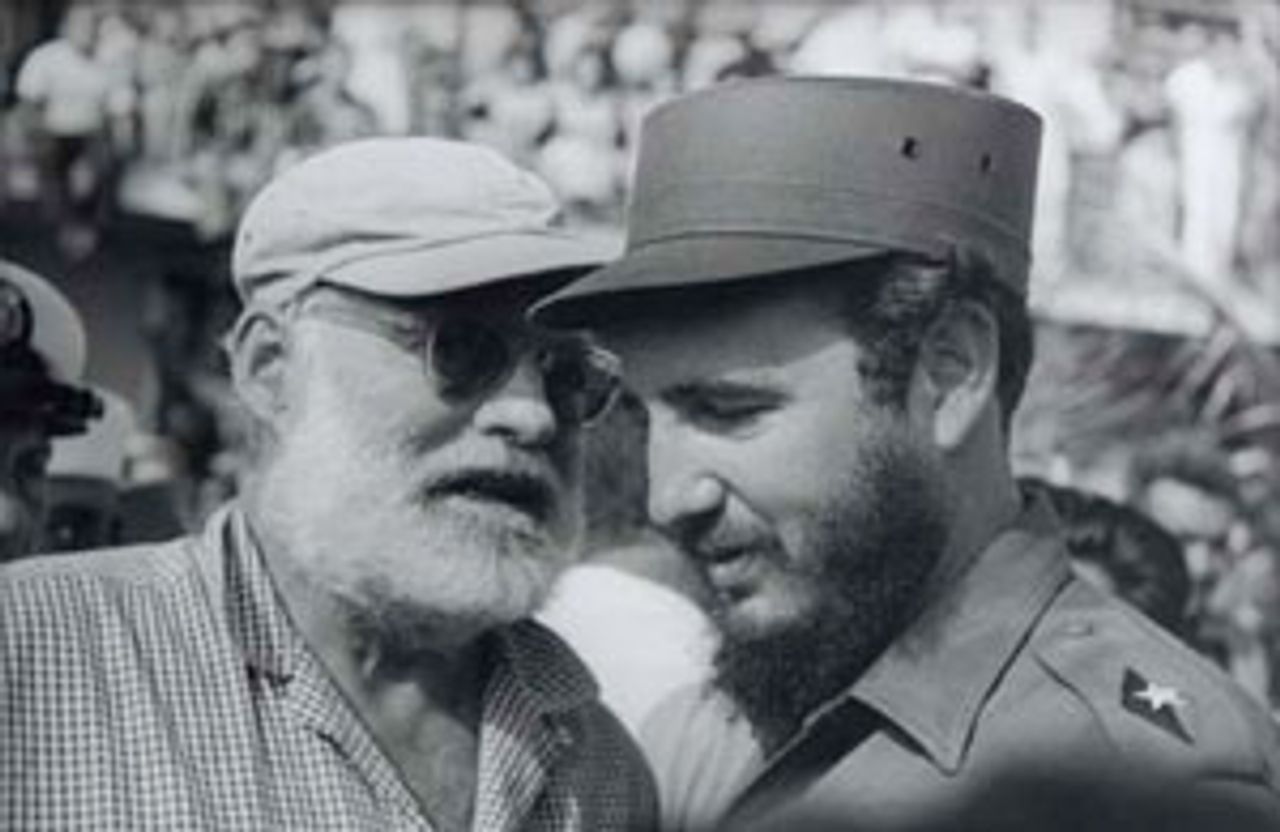 Hemingway and Castro
Hemingway and CastroIn 1959 Hemingway bought a home in Ketchum, Idaho. Although he left Cuba following the coming to power of Fidel Castro’s forces, he remained on good terms with the Castro regime and told the New York Times he was “delighted” with the ouster of the US-backed Batista. This apparently set off alarm bells at FBI headquarters, ever vigilant for any hint of opposition.
There were signs of mental deterioration in 1960. He became suddenly worried about money and his safety. He was admitted to the Mayo Clinic in November 1960, where he reportedly received electroconvulsive therapy as many as 15 times, and was released in January 1961, according to a biographer, “in ruins.”
His friends detected what they perceived to be paranoia. Hemingway was convinced the FBI was actively monitoring his movements. In the New York Times this July 1, A.E. Hotchner, a friend of Hemingway’s for years, explained that the writer “was afraid that the FBI was after him, that his body was disintegrating, that his friends had turned on him, that living was no longer an option.”
Writes Hotchner, “Decades later, in response to a Freedom of Information petition, the FBI released its Hemingway file. It revealed that beginning in the 1940s J. Edgar Hoover had placed Ernest under surveillance because he was suspicious of Ernest’s activities in Cuba. Over the following years, agents filed reports on him and tapped his phones. The surveillance continued all through his confinement at St. Mary’s Hospital. It is likely that the phone outside his room was tapped after all.”
Hotchner adds: “In the years since, I have tried to reconcile Ernest’s fear of the FBI, which I regretfully misjudged, with the reality of the FBI file. I now believe he truly sensed the surveillance, and that it substantially contributed to his anguish and his suicide.”
On July 2, 1961, Hemingway killed himself with a shotgun blast.
Hemingway said, “The hardest thing in the world to do is to write straight, honest prose on human beings.” He did that in much of his work. He deserves to be read widely.
These are some of the works I would recommend:
Novels, memoirs, etc.:
The Sun Also Rises
A Farewell to Arms
For Whom the Bell Tolls
A Moveable Feast
The Complete Short Stories of Ernest Hemingway (The Finca Vigia Edition)
Among the stories:
Spain:
“The Capital of the World”
“A Clean, Well-Lighted Place”
“Old Man at the Bridge”
“The Denunciation”
“Night Before Battle”
“Under the Ridge”
“Landscape with Figures”
Africa:
“The Short Happy Life of Francis Macomber”
“The Snows of Kilimanjaro”
Italy (and WWI):
“In Another Country”
“Che Ti Dice la Patria”
“A Way You’ll Never Be”
“A Natural History of the Dead”
Michigan:
“Indian Camp”
“The Doctor and the Doctor’s Wife”
“The End of Something”
“The Three-Day Blow”
“Big Two-Hearted River: Parts I and II”
“The Light of the World”
“Summer People”
“The Last Good Country”
“Fathers and Sons”
